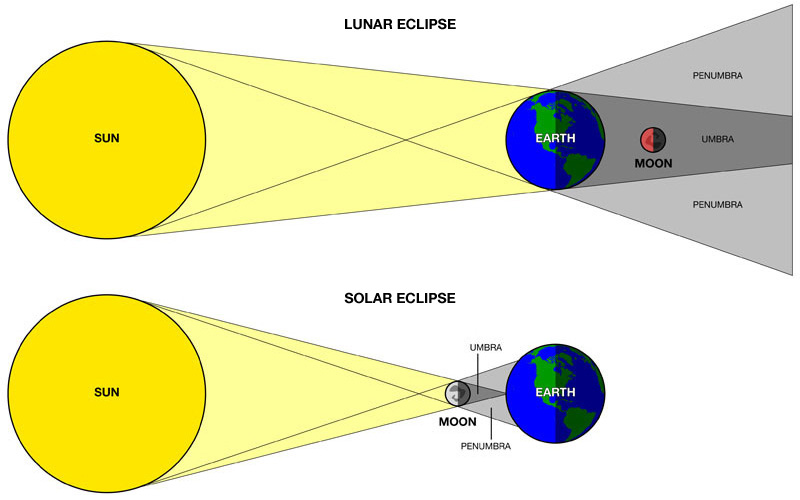Have you ever been mesmerized by the beauty of an eclipse? Whether it's the sun disappearing behind the moon or the moon taking on a reddish hue during a lunar eclipse, these celestial events captivate people around the world. Eclipses have been a source of fascination and intrigue throughout history, and the differences between a solar eclipse and a lunar eclipse are essential for any astronomy enthusiast or curious observer to understand. Both phenomena showcase the breathtaking dance of the Earth, moon, and sun, yet they are strikingly different in appearance and occurrence.
The solar eclipse occurs when the moon passes between the Earth and the sun, casting a shadow on the Earth and temporarily blocking the sun's light. In contrast, a lunar eclipse happens when the Earth passes between the sun and the moon, causing the Earth's shadow to fall on the moon. Each of these events has its unique characteristics, visibility, and frequency, adding to their allure. Understanding the differences between a solar eclipse and a lunar eclipse can enhance your appreciation for these remarkable astronomical occurrences.
As we delve into the world of eclipses, we will explore their definitions, types, and significance, along with some fascinating historical and cultural perspectives. Join us as we uncover the mysteries behind solar eclipses and lunar eclipses, and learn how to best witness these spectacular events in the night sky.
What is a Solar Eclipse?
A solar eclipse occurs when the moon moves between the Earth and the sun, blocking the sun's light either partially or completely. This event can be further classified into three main types:
- Total Solar Eclipse: The moon completely covers the sun, resulting in a short period of darkness during the day.
- Partial Solar Eclipse: Only a portion of the sun is obscured by the moon.
- Annular Solar Eclipse: The moon is too far from the Earth to completely cover the sun, resulting in a "ring of fire" effect around the moon.
What is a Lunar Eclipse?
A lunar eclipse occurs when the Earth passes between the sun and the moon, causing the Earth's shadow to block the sun's light from reaching the moon. There are three main types of lunar eclipses:
- Total Lunar Eclipse: The entire moon passes through the Earth's shadow, often taking on a reddish color.
- Partial Lunar Eclipse: Only a portion of the moon enters the Earth's shadow.
- Penumbral Lunar Eclipse: The moon passes through the Earth's outer shadow, resulting in a subtle shading on the moon's surface.
How Often Do Solar and Lunar Eclipses Occur?
The frequency of solar and lunar eclipses varies each year. On average, there are about:
- 2 to 5 solar eclipses
- 2 to 4 lunar eclipses
However, not every eclipse is visible from every location on Earth. The visibility depends on the alignment of the Earth, moon, and sun, as well as the observer's geographical location.
How Do Solar Eclipses and Lunar Eclipses Differ in Appearance?
The visual experience of a solar eclipse and a lunar eclipse is strikingly different. During a solar eclipse, viewers may witness the sun being covered by the moon, resulting in a dramatic darkening of the sky, a drop in temperature, and the appearance of stars and planets. In contrast, a lunar eclipse offers a more subtle yet equally captivating sight, as the moon transitions through shades of red and brown, creating a stunning celestial display.
What Are the Cultural Significances of Eclipses?
Eclipses have held cultural significance across various civilizations throughout history. For many ancient cultures, eclipses were seen as omens or messages from the gods. For example:
- The ancient Greeks believed that solar eclipses heralded disasters.
- In Chinese culture, eclipses were thought to signify the emperor's loss of favor.
- The Mayans used their knowledge of celestial events to create calendars and predict agricultural cycles.
Today, eclipses are celebrated worldwide, with festivals and gatherings taking place to witness these awe-inspiring events.
How Can You Safely View a Solar Eclipse?
Viewing a solar eclipse requires special precautions to protect your eyes. Here are some tips:
- Use eclipse glasses or a solar viewer specifically designed for solar observation.
- Avoid looking directly at the sun without proper protection, as it can cause severe eye damage.
- Do not use regular sunglasses, as they do not provide adequate protection.
How Can You Witness a Lunar Eclipse?
Unlike solar eclipses, lunar eclipses are safe to observe with the naked eye. Here are some tips for enjoying a lunar eclipse:
- Find a dark location away from city lights for optimal viewing.
- Use binoculars or a telescope for a closer look at the moon's surface.
- Capture the moment with a camera, but remember to use a tripod for stability.
Conclusion: Solar Eclipse vs Lunar Eclipse – Which One is More Fascinating?
Both solar and lunar eclipses offer unique celestial experiences that ignite our sense of wonder and curiosity about the universe. While solar eclipses provide a dramatic spectacle of light and shadow, lunar eclipses enchant us with their subtle transformation of the moon. Ultimately, whether one finds solar eclipses or lunar eclipses more captivating depends on personal preference and the opportunity to witness these incredible astronomical events. No matter which type of eclipse you prefer, both remind us of the intricate dance of celestial bodies that govern our skies.




